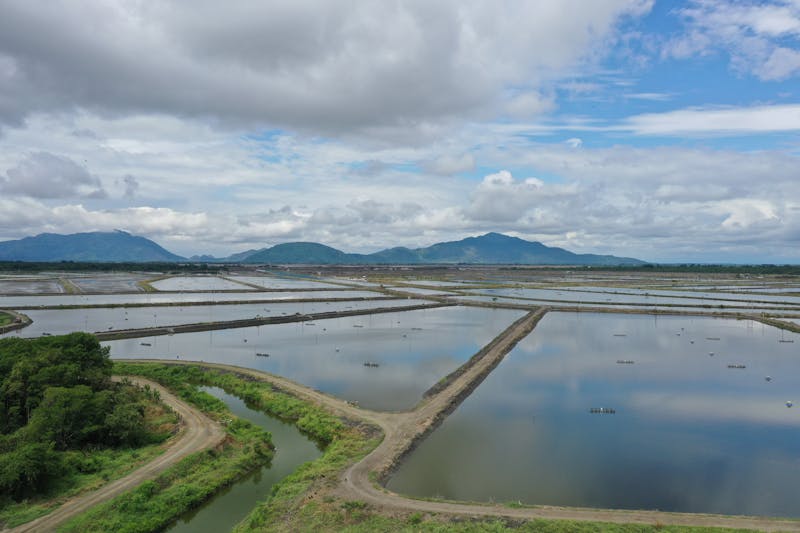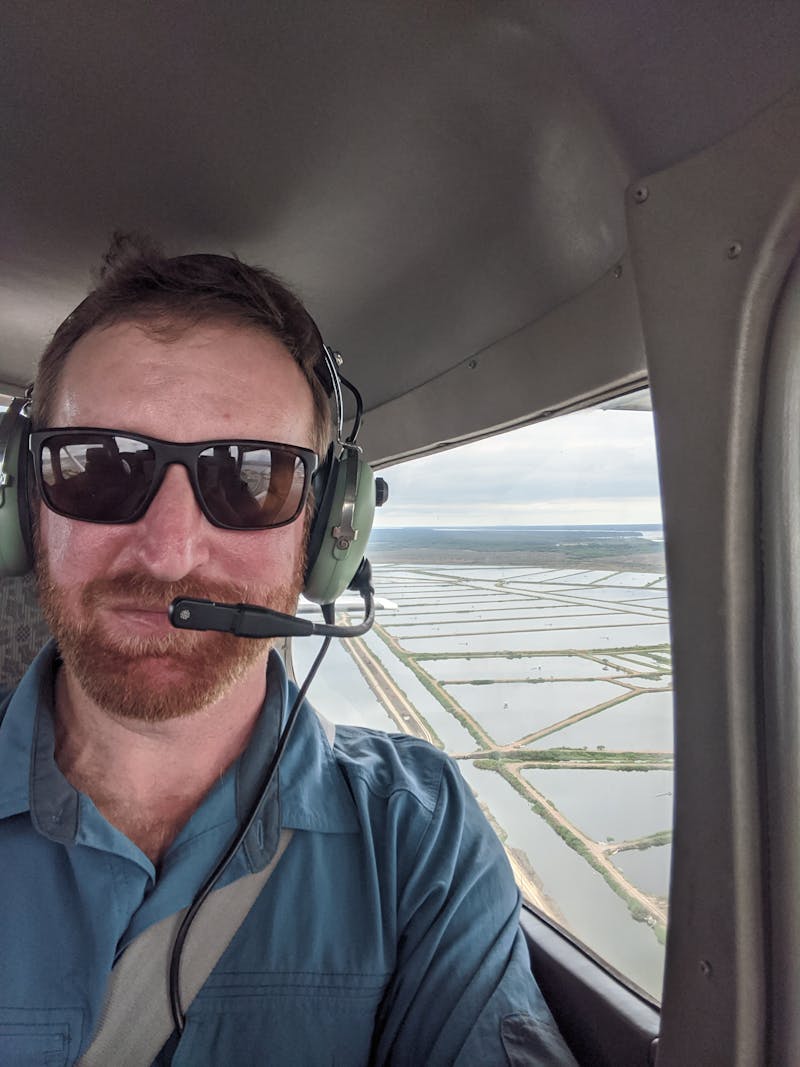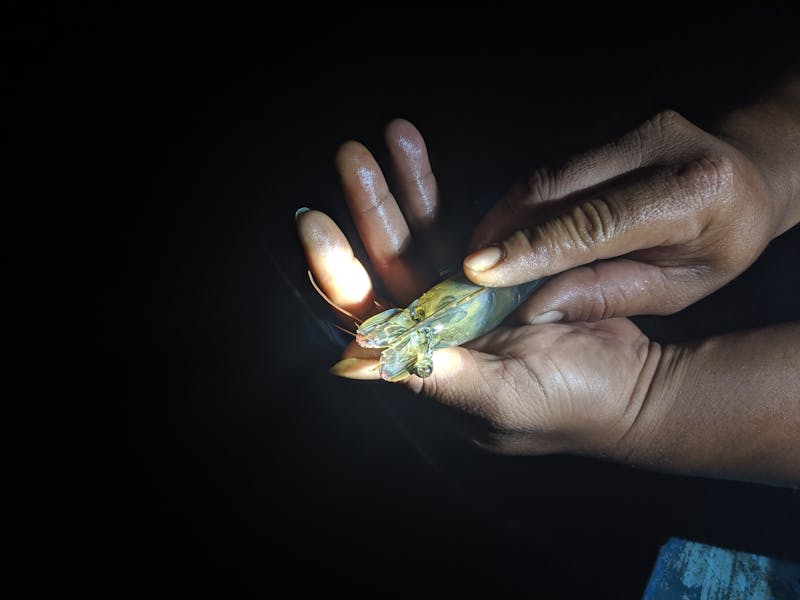Aquaculture — a fancy term for farming fish and other aquatic animals — has been criticized for years.
But Dane Klinger wants you to know that it could be essential to feeding the planet, fighting climate change, protecting marine life and supporting small farmers — if done right.
Over the last 30 years, shrimp farms have increased production by more than 1,000 percent. But this dramatic growth has often come at the expense of nature, specifically mangrove forests, which in many countries have been cut down to make way for shrimp farms.
Klinger, Conservation International’s aquaculture expert, developed a first-of-its-kind approach to farming shrimp that boost farmers’ yields, while conserving and restoring climate-critical mangrove forests.
Conservation News sat down with him to talk about the shrimp industry and why it’s time to disrupt it.
Aquaculture farm in Ecuador.
What sparked your passion for marine science?
Dane Klinger: I grew up on the Chesapeake Bay and loved exploring its beaches and tidal marshes. But over the years, I began to notice subtle changes — like in some years jellyfish would arrive in May, while in others they wouldn’t come until July. This made me think about the cycles in nature and all the subtle factors that drive them.
At its core, science is all about observing patterns. Whether it’s in nature, the human body or the cosmos, seeing a pattern — or spotting its interruption — is the way we test hypotheses, develop theories and make predictions about how the world works. I’ve always been fascinated by this — particularly in aquatic environments, where even minor changes can trigger cascading effects, potentially leading to ecosystem collapse.
Klinger touring shrimp farms in Ecuador.
What led to your interest in aquaculture?
DK: After college, I started working on fisheries management, which is about catching wild fish responsibly. But gradually I began to see aquaculture as an exciting, and essential, new frontier — one with a ton of untapped potential. It’s growing like crazy and is now responsible for more than half of all seafood we consume. Over the last few decades it’s been the fastest growing sector in food production worldwide.
What was most important to me is that aquaculture has the potential to dramatically increase food production with a relatively small environmental footprint — but only if it’s done sustainably. When it isn’t, it can have massive negative environmental impacts. I wanted to be a part of solving that puzzle.
Could you walk me through the issues?
DK: Yes, let’s look at farmed shrimp. Some of the negative things you’ve likely heard are true. Shrimp farming contributed to the destruction of mangroves — in total, about 40 percent of them have been lost, particularly from the 1980s to the early 2000s, as forests were cut down to build more shrimp ponds. More recently, deforestation rates have slowed due to stronger regulation, but a new challenge is emerging. As coastal areas to build new farms are now limited and shrimp has evolved from a local commodity to a global one, many farmers want to intensify their shrimp farms — producing more on the same land. This increases the risk of disease outbreaks, which tend to happen when shrimp are crammed into too small of a space, and the risk of polluting local waterways if runoff from farms isn’t treated properly. Additionally, farmers often don’t have access to financing or technical expertise to intensify their operations in a responsible way.
Is it possible to meet this soaring demand without deforesting mangroves or polluting the environment?
DK: Absolutely. My “aha” moment happened when I realized we could disrupt a destructive pattern by addressing two challenges simultaneously. We wanted to help shrimp farmers responsibly increase production on part of their land, while restoring mangroves on the rest. I hoped it could be a win-win situation — increase shrimp production, improve shrimp farmers’ income and restore degraded mangroves, which, of course is good for the climate and wildlife.
How does that work in practice?
DK: Traditionally, small shrimp farmers keep things simple. They might add a bit of fertilizer to boost natural productivity, but they don’t heavily stock ponds or provide much added food for the shrimp. Productivity on these farms remains low: Picture 1,000 pounds worth of shrimp — roughly the amount that would fill the trunk of a Honda Accord — on a two-acre farm.
What we’re doing is taking half that land and restoring it as a mangrove forest, while helping farmers increase their output on the rest. We begin by stocking larval shrimp, adding feed for the shrimp, and keeping an eagle eye on water quality factors like temperature, oxygen levels and salinity to create the ideal conditions for shrimp growth and health. Aerators might be introduced to ensure optimal oxygen levels. Automatic feed dispensers can be used to ensure proper nutrition and growth. Pond liners made of plastic or concrete are often used to ensure more precise control over the shrimp’s environment.
We have two pilot programs taking place right now in Ecuador and Indonesia, where we’re providing financing and expertise to help farmers produce more shrimp, make more money and restore mangroves. We’re in the process of scaling this approach by setting up a dedicated loan fund that will enable shrimp farmers to transition to more sustainable and efficient production systems — and developing AI-based tools to identify optimal sites for mangrove restoration.
Aquaculture pilot program in Indonesia.
But more shrimp in a confined area means a higher potential for disease and mortality.
DK: Right, and that’s where we’re innovating with new technology to minimize these risks.
A little while back, CI Ventures — Conservation International’s investing arm — provided funding for a woman-owned aquaculture technology company called JALA, which has really disrupted the industry. It’s giving small and medium-sized farms the technology to function with the efficiency and effectiveness of a large corporate farm.
JALA started out by providing a low-cost water quality sensor to farmers. Other companies like them were offering similar things — one provided a larval counter, another an auto-feeder. The deployment of this hardware across hundreds of farms allowed these companies to collect a treasure-trove of data. It essentially became a guidebook for a farm’s success or failure — what conditions lead to better profitability, better production, less disease-risk?
And JALA delves further: They’ve been able to increase the flow of financing towards small and medium-sized farms by profiling individual farmers’ risk and performance for banks. This not only assists the farmers but also invigorates the entire sector.
In the past this was only stuff that very large corporate farms could do. It’s like a democratization of data, technology and effective management.
And how about the shrimp themselves? Have there also been advances in animal welfare?
DK: Fortunately, yes.
Take, for example, a common practice known as eyestalk ablation. Back in the 1960s, researchers were struggling to get shrimp to reproduce in captivity. But then French scientists came up with a truly wild solution. By removing one eye from female shrimp, they had no problem breeding in captivity. As a result, we now have one-eyed shrimp in almost every marine shrimp maturation and reproduction facility in the world.
However, the industry has since made remarkable headway, uncovering ways to prompt shrimp to spawn in captivity without resorting to this practice. The focus now pivots towards making this alternative approach mainstream. A coalition of consumer, NGO and industry groups is actively working to end eyestalk ablation.
Eyestalk ablation in a fish hatchery.
This brings us full circle, back to consumers. How can we know that the shrimp we’re buying is sustainable?
DK: There are two primary sustainability certifications to look for on farmed shrimp and fish packaging — Best Aquaculture Practices and Aquaculture Stewardship Council. I’m on the board for the latter, but both have environmental and social responsibility standards that can help consumers make wiser choices.
But in the grand scheme of things, sustainable aquaculture doesn’t stop at the farm. The entire industry, including feed manufacturers, hatcheries, processors, importers, retailers and restaurant owners, and each of us, has a role to play in incentivizing and adopting responsible practices throughout the supply chain — from what the fish are fed to how they end up on your dinner table.
All food production has some impact on the environment. A core concept in economics is the notion that “there’s no such thing as a free lunch,” and that is literally true in food production. Aquaculture, when done right, has a large role to play in producing more food with relatively less environmental harm. I’m proud to be a part of that effort.
Further reading
Will McCarry is a staff writer at Conservation International. Want to read more stories like this? Sign up for email updates. Also, please consider supporting our critical work.



